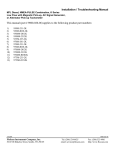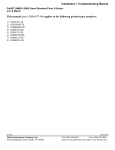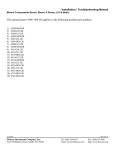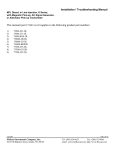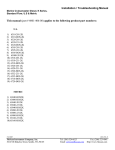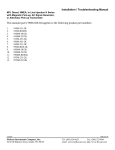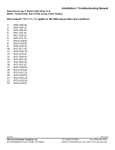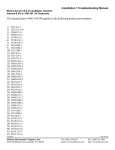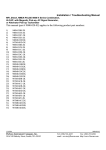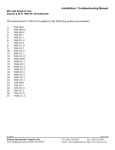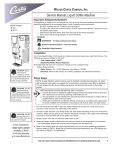Download Installation / Troubleshooting Manual
Transcript
Installation / Troubleshooting Manual Diesel Fuel Log, K Series Standard Flow, U.S. Metric, Temp-Comp, Non Temp-Comp, Pulse Output This manual (7000-316-14) applies to the following product part numbers: 1) 2) 3) 4) 5) 6) 7) 850L-201-2K 850L-231-2K 850L-BOS-2K 850L0-2012K 850L0-BOS2K 85TL-235-2K 85TK-235-2K 6/22/2005 FloScan Instrument Company, Inc. 3016 NE Blakeley Street, Seattle, WA 98105 7000-138-80 Tel: (206) 524-6625 email: [email protected] Fax: (206) 523-4961 http://www.floscan.com ! FUEL LOG INSTALLATION PLANNING ! READ ME FIRST - Detailed Mechanical & Electrical Planning Saves Installation Hours! FloScan K Series systems are not difficult to install. Installation requires only basic electrical & mechanical skills. With forethought and planning, your system will be installed with few problems. Todd Walker, Yacht Electric Co., (954) 325-9091 regularly installs FloScan K Series Twin Diesel Systems in about 10 hours. Difficult installations may take several hours longer. I. Installation Preparation: Review the pre-installation booklet, mechanical installation instructions, and survey your vessel. Determine where the Sensor(s), Sensor Assemblies, Switches and Instruments are to be mounted. Place them at their approximate locations. Determine fitting size and types required for each plumbing connection, (JIC, SAE, NPT, NPTF, or Hose Barb). FloScan K-Series Hi-Cap Diesel Forward Sensor Assemblies have 1” Female NPT ports. FloScan K-Series Hi-Cap Diesel Return Sensor Assemblies have 1” inlet and ½” outlet Female NPT ports. FloScan Hi-Flo, (-10) Diesel and Gasoline Sensors have ½” Female NPT ports. FloScan K-Series Lo-Flo Diesel and Gasoline System Components, (Sensors and Pulsation Dampers) have ¼” Female NPT ports. Review the electrical installation instructions. Open and survey your vessels wire ways. Determine if it would be easier to run a 3conductor cable from each sensor to the instrument, or install a junction box, (J-Box) with terminal strip in the engine room. The JBox requires a 4-conductor cable from it to the instrument, and a 3-conductor cable from each sensor. Measure cable lengths from sensor(s) to J-Box, (If used) to Instrument. Tachometers require a separate 2-conductor cable. If there’s an existing tachometer, its signal wires can be used. II. Mechanical Installation: Install or mount the Sensor(s) or Sensor Assemblies, Instruments and Switches, (Reset, MPG). III. Plumbing: Most K Series and -10 installations do not require additional fuel hose. Mount the sensor(s) or sensor assemblies where they’re to be installed. On installations using Fabric Braid A-1 Fuel Hose install the correct HB X MNPT fitting into each sensor or sensor assembly. Always assemble fittings using a fuel proof pipe thread sealant. Never use Teflon Tape. Use a hose cutter or knife to cut the fuel hose. Next install the hose onto the barb fittings. Hose should not be twisted, have adequate slack, an ample radius at all bends and be supported at reasonable distances, approximately 2-4 feet. When clamping hose onto the barbs, use 2 narrow or 1 wide stainless hose clamp on each hose end. Wire Braid A-1 Aeroquip Type Fuel Hose or Hydraulic Hose: Mount the sensor(s) or sensor assemblies where they’re to be installed. Mark the hose where it is to be cut. Remove hose and bring it to a hydraulic shop. Have them cut the hose and install hose ends. Reinstall the hoses and install the correct fitting into each sensor or sensor assembly. Always assemble fittings using a fuel proof pipe thread sealant. Never use Teflon Tape. Hoses should not be twisted, have adequate slack, an ample radius at all bends and be adequately supported at reasonable distances, approximately 2-4 feet. AP-50 copper sealing washers, (Connie Seals) or Flaretite seals may be required to seal JIC & SAE fittings. IV. Electrical Installation: Run cables between Sensor(s), J-Box, (If used) and Instrument(s). Cables must be adequately supported at reasonable distances, approximately 2-4 feet. Wire Terminations—Referring to the wiring diagram. Connect Sensor, Instrument and Switches to their respective wires with crimp type butt or ring connectors. Always cover connectors and wire ends with heat shrink tubing. 12/8/2004 FloScan Instrument Company, Inc. 3016 NE Blakeley Street, Seattle, WA 98105 7000-339-00 Tel: (206) 524-6625 Fax: (206) 523-4961 email: [email protected] http://www.floscan.com V. Pre-Startup: Prime the fuel system. If you have an electric priming or boost pump, circulate fuel for 10 minutes while checking for leaks. If not, use the engines manual pump. Before starting, open the lift pumps’ outlet fitting slightly. Before start-up, verify that all fuel system fittings are tight. VI. System Start-Up: Start and run your engines. Look for leaks and other installation problems. If system is not operating properly refer to the Troubleshooting Instructions and correct any deficiencies. VII. Calibration: When system is running properly, refer to the calibration instructions and calibrate your system. If installed properly, initial calibration takes less than 1 hour. After consuming some fuel, final calibration should only take a few minutes. USCG approved fuel hose with either fabric or wire reinforcing braid meet the following standards: Hose Marking USCG Type A-1 USCG Type A-2 USCG Type B-1 USCG Type B-2 Permeation Rating 100g/m²/24hrs. 300g/m²/24hrs. 100g/m²/24hrs. 300g/m²/24hrs. 2½ Minute Fire Test Required Required Not Required Not Required Table I 12/8/2004 FloScan Instrument Company, Inc. 3016 NE Blakeley Street, Seattle, WA 98105 7000-339-00 Tel: (206) 524-6625 Fax: (206) 523-4961 email: [email protected] http://www.floscan.com Installation Do’s & Don’ts Do Don’t Use a Fuel Proof Pipe Thread Sealant when assembling fittings into fuel system components, (Locktite PST, Leak-Lock, or equivalent). Never use Teflon Tape or Permatex Thread Sealant! Use thin wall, low pressure, full flow type NPT or NPTF hose barb fittings. Double clamp all hose barb fittings. Don’t use Push-Lok, or Barb-Tite fittings. Avoid using JIC or SAE swivel fittings. If used always install copper conical sealing washers, (Connie seals) or fitting seals on fittings. Avoid using 90º elbow fittings. Install Sensor(s) at a low point in the fuel system, as far from the engine as practical. Fuel must travel, If possible, avoid bolting or mounting sensor(s) “Up-hill” slightly after leaving the sensor. Verify directly onto the engine. correct orientation and fuel flow direction. Always install Forward Sensors on the Fuel Pumps’ Inlet or Vacuum side. Never install on the Pressure Side Always use 30-micron primary filters. Avoid 2 or 5 micron primary filters. Connect all, “Ground” wires to a Ground Buss, or directly to the Battery’s Negative Terminal. Connect Never connect Instrument or Sensor “Ground” wires to the hull, engine block, or other or, “Ground” wire shields to the engine block. machinery. Always use non-illuminated switches for Totalizer Reset. 12/8/2004 FloScan Instrument Company, Inc. 3016 NE Blakeley Street, Seattle, WA 98105 Never use illuminated, or back-lit switches. 7000-339-00 Tel: (206) 524-6625 Fax: (206) 523-4961 email: [email protected] http://www.floscan.com ELECTRICAL Series 75/76, 85/86, 95/96 Series Diesel Fuel Log SET UP Wire & Switches: Use 18 AWG stranded wire on runs under 50’. For runs over 50’ use 16 AWG. Shielded wire is recommended for all Diesel systems and suggested for Inboard & I/O gasoline systems. Always, “Ground” the wire shield or shield drain wires in the engine room by connecting them to the bonding system or engine block. FloScan suggests using J-Boxes, Terminal Blocks, and three conductor cables between diesel sensors and instrument to make wiring easier. Install Single Pole Single Throw (SPST) switches for Hours & Gallons Reset, (switches are not included with kit). Grounding: Each Black sensor wire must be connected directly to the Black, “Instrument Ground” wire. Use a single wire to connect the Black wire junction to the battery’s negative terminal, or a ground buss. Power: FloScan Instruments & sensors operate on 9 to 12 VDC. Voltages exceeding 16 VDC will damage equipment. 24 & 32 VDC systems must be reduced to 12 VDC. Two different types of voltage reducers are available through FloScan. WIRE CONNECTIONS Installation: Connect wires one at a time and install heat shrink tubing before proceeding to the next wire, (refer to diagram). Connect ground wires first, (BLACK instrument ground wire to the BLACK sensor wires). Connect this junction to the battery’s negative terminal or the ground buss. Connect all other wires leaving the Red power wires for last to prevent short circuits during installation. Splicing: Splice or join individual wires per the diagram. Slide heat shrink tubing over the splices to prevent shorts. Do not seal splices until the installation is finished and has been tested. 1. Slide heat shrink tubing over one wire. 2. Insert wire ends into butt splice. 3. Crimp butt splice. 4. Slide heat shrink tubing over butt splice. HEAT 5. Apply heat. An adequate number of crimp-on connectors and heat-shrink tubing are included with system. The heat-shrink is a special type that will bond to wire insulation and make a watertight connection. See diagram for proper tubing application. Crimp-on connectors are sized for 18 or 20 gauge stranded wire. FINAL ACTIONS Check Electrical Installation: Test all connections. Support and secure all dangling wires. Start engine and calibrate system. 12/8/2004 FloScan Instrument Company, Inc. 3016 NE Blakeley Street, Seattle, WA 98105 7000-331-00 Tel: (206) 524-6625 Fax: (206) 523-4961 email: [email protected] http://www.floscan.com 12/8/2004 FloScan Instrument Company, Inc. 3016 NE Blakeley Street, Seattle, WA 98105 7000-331-00 Tel: (206) 524-6625 Fax: (206) 523-4961 email: [email protected] http://www.floscan.com WIRING DIAGRAM Series 8500/8600 Pulse Output Diesel Fuel Log Instrument Connection Harness FUNCTION PIN # RED Not Connected (twin applications see note below) 9 RED/WHITE + pulse out 10 WHITE/YELLOW +pulse in (Twin applications) 11 ORANGE Illumination + 12VDC 12 BLACK Instrument Ground 13 WHITE Forward Flow Sensor signal 14 GREEN/BLACK (-) pulse out 15 YELLOW Not Connected 16 PIN # 1 2 3 4 5 6 7 8 FUNCTION RED + 12VDC GREEN Totalizer Reset Not Connected BLACK Jumper to pin # 13 BLACK Jumper to pin # 12 BROWN Not Connected BLACK Reset Ground VIOLET Not Connected 0 0 BLACK 0 RED E GREEN F 0 1 2 D C B 3 4 5 A 9 8 7 6 16 15 14 13 12 11 10 9 8 7 6 5 4 3 2 1 BACK OF INSTRUMENT Single Sensor Installations RED 6 WHITE CABLE 1/2 amp fuse 9 BLACK 4 ORANGE To Ignition Switch (Key ON = + 12VDC) 10 GREEN To + Panel Illumination + 12VDC BLACK 15 Totalizer Reset Switch (momentary ON) 5 Battery (-) buss BLACK B R R B W CABLE B W Flow Sensor WHITE RED 7 2 GREEN/BLACK (-) Pulse Out To External Computer (if applicable) RED/WHITE (+) Pulse Out NOTE: This diagram is used for Diesel systems requiring only one (1) sensor in the fuel system. 12/8/2004 FloScan Instrument Company, Inc. 3016 NE Blakeley Street, Seattle, WA 98105 7000-338-00 Tel: (206) 524-6625 Fax: (206) 523-4961 email: [email protected] http://www.floscan.com Instrument Connection Harness FUNCTION PIN # RED Not Connected 9 RED/WHITE + pulse out 10 WHITE/YELLOW + pulse in (Twin applications) 11 ORANGE Illumination + 12VDC 12 BLACK Instrument Ground 13 WHITE Forward Flow Sensor 14 GREEN/BLACK (-) pulse out 15 YELLOW Not Connected 16 PIN # 1 2 3 4 5 6 7 8 FUNCTION RED + 12VDC GREEN Totalizer Reset Not Connected BLACK Jumper to pin # 13 BLACK Jumper to pin # 12 BROWN Return Flow Sensor BLACK Reset Ground VIOLET Not Connected 0 0 BLACK 0 RED E GREEN F 0 1 2 D C B 3 4 5 A 9 8 7 6 16 15 14 13 12 11 10 9 8 7 6 5 4 3 2 1 BACK OF INSTRUMENT Forward and Return Sensor Installations BROWN 1/2 amp fuse To Ignition Switch (Key ON = + 12VDC) 9 RED BLACK 7 2 6 WHITE CABLE 14 5 4 ORANGE GREEN/BLACK (-) Pulse Out To External Computer (if applicable) or refer to Wiring Diagram sheet 9000-016-00-C RED/WHITE (+) Pulse Out To + Panel Illumination + 12VDC Battery (-) buss BLACK R R B B W CABLE B W Forward Flow Sensor WHITE RED R R BROWN 10 B WHITE GREEN B W BLACK CABLE B W Return Flow Sensor 15 Totalizer Reset Switch (momentary ON) 12/8/2004 FloScan Instrument Company, Inc. 3016 NE Blakeley Street, Seattle, WA 98105 7000-338-00 Tel: (206) 524-6625 Fax: (206) 523-4961 email: [email protected] http://www.floscan.com INSTALLATION MECHANICAL & WIRING OVERVIEW, (K Series & -10 Systems) To Ensure System Accuracy, Follow All Installation Instructions. • Sensor Placement. Determine where the Flow Sensor, or Flow Sensor-Pulsation Damper assembly is to be installed. Install the sensor, or sensor-pulsation damper assembly so that the two fuel flow arrows, (Î Î) or the, (IN and OUT) markings are on a horizontal plane. All orientation arrows, (Ï) must be pointing up. The forward sensor or forward sensor-pulsation damper assembly must be installed downstream of the primary filter. Do not install the sensor or either sensor assembly at a high point in the fuel system. This could negatively impact system accuracy by trapping air. The fuel return line between the return sensors’ outlet port and fuel tank should be at least 12” long and have a 1 to 2” upward rise. This keeps the return sensor flooded, improving accuracy. Place sensor assemblies in a protected location away from water spray. Forward Sensor & Pulsation Damper Assembly Return Sensor & Pulsation Damper Assembly FloScan Inlet Outlet FloScan Forward Sensor And Pulsation Damper Assembly Inlet Outlet 233/ 236-1K & 2K Outlet Inlet 233/ 236-2K Return Sensor And Pulsation Damper Assembly FloScan FloScan Outlet Inlet 201/ 231-1K & 2K, 235-2K Inlet FloScan 201/ 231/ 235-2K Outlet Outlet Inlet 233C-10 & 233D-10 (Cummins PT Systems) 8/5/2003 FloScan Instrument Company, Inc. 3016 NE Blakeley Street, Seattle, WA 98105 ARROW UP 231-10 (Cummins PT Systems) 4001-325-00F Tel: (206) 524-6625 Fax: (206) 523-4961 email: [email protected] http://www.floscan.com • Determine fitting type & size. Minimize the number of elbows and fittings. If swivel fittings are used, (JIC or SAE) their mating surfaces must be sealed with Copper Conical Sealing Washer, (Connie Seals) or fitting seals. Fitting seals may be purchased through Fittings Inc. in Seattle, WA (206) 767-4670, 1-800-552-0632, or a local hydraulic supply house. • Select Instrument Mounting Location. The instruments’ face is waterproof and a gasket is provided to seal its bezel to the control panel. Choose a location away from the compass. Install 65/6600 series instruments 12” away from compass. Choose a shaded location since direct sunlight may cause the LCD display to temporarily turn. This does not damage the LCD, but makes it impossible to read until cooling down. Make a cutout in the instrument panel for the instrument. The instruments’ maximum depth is 3 ½” minus the thickness of the console panel. Instrument Series 6500/6600 7500/7600, 8500/8600, 9500/9600, TwinScan • Cutout Size 3 1/16” 3 3/8” Wiring. Determine wiring run length and the number of switches needed, (always use good quality marine grade switches). Use 18 AWG conductors on runs under 50’. 16 AWG for runs over 50’. • Run & Connect Wires. Wire one system at a time. Always begin with the Black, “Ground” wires. Each Black sensor wire must be connected to the Black, “Instrument Ground” wire. Use a single wire to connect these Black wires to the battery’s negative terminal, or to the ground buss. For the system to operate properly the, “Ground” wires must be connected in this manner. Connect other wires per the wiring diagram. Leave the RED, power wire for last. • Tachometer Installation Options. 75’7600, 85/8600, and 95/9600 series tachometers require one or two additional wires. If your engine isn’t equipped with a tachometer sender determine which type it requires, (AC Signal Generator or Magnetic Pickup) and install one. Some engine alternators produce a tachometer signal and can be used as the tachometer sender. Mechanically driven AC signal generators and magnetic pickups are available from FloScan and most marine dealers. Hewitt, Motorola, VDO and Stewart Warner are some of the more common brands. 1. Keep Existing Tachometer(s). Connect the FloScan tachometers’ Yellow and Violet signal wires to the existing tachometer. If the tachometer sender wire(s) are not marked, trace them from the tachometer sender up to the existing tachometer. If one sender lead is grounded, connect the FloScan tachometers Yellow signal wire to the ungrounded lead or terminal. Connect the VIOLET wire to a Ground Buss, or Battery Minus. 8/5/2003 FloScan Instrument Company, Inc. 3016 NE Blakeley Street, Seattle, WA 98105 4001-325-00F Tel: (206) 524-6625 Fax: (206) 523-4961 email: [email protected] http://www.floscan.com 2. Replace Existing Tachometer(s). FloScan MFI instruments have a 3 3/8” outside diameter. This is a common size and fits into most instrument mounting holes. Identify the engines’ tachometer sender wires. Connect the FloScan tachometers’ Yellow and Violet signal wires to the sender wires. If one sender lead is grounded, connect the FloScan tachometers Yellow signal wire to the ungrounded lead or terminal. Connect the VIOLET wire to a Ground Buss, or Battery Minus. 3. New Tachometer(s). Run a dedicated shielded pair of wires between the instrument and tachometer sender, (This is especially important with Magnetic Pickup senders). Ground the shield only in the engine room. • Magnetic Pickup & AC Signal Generator Tachometer Senders: Connect the FloScan tachometers’ Yellow signal wire to one sender terminal. Connect the Violet wire to the other terminal. Engine Alternators: Connect the FloScan tachometers Yellow signal wire to the alternators’ tachometer output terminal. This terminal is usually marked as TACH, or SIG. Connect the VIOLET wire to a Ground Buss, or Battery Minus. • • Pre-Startup & Installation Check. Prime the fuel system. If you have an electric priming or boost pump, circulate fuel for 10 minutes while checking for leaks. If not, use the engines manual pump. Before starting, “Crack” the lift pumps’ outlet fitting slightly. Continue pumping until system is fully primed. Before start-up verify that all fuel system fittings are tight. • System Start-Up. Start and run your engines. Survey the installation for leaks and other problems. If the system is not operating properly refer to the Troubleshooting Instructions and correct any deficiencies. When the engine reaches operating temperature increase engine speed to about 1500-2000 RPM. Letting it run for five or ten minute’s helps purge residual air from the system. • Any vacuum leaks between the fuel tank and lift pump will allow air to be drawn into the system. These leaks cause high and/or fluctuating GPH readings. Only severe leaks affect engine performance, but all leaks affect sensor performance and instrument readings. Vacuum or suction leaks occur at improperly sealed primary filters, loose packing nuts on cross over & shut off valves and improperly sealed fittings. Vacuum leaks can also occur from corroded copper fuel lines and chaffed fuel hose, (where it rubs against bulkheads or engine parts). To verify that a suction leak is present, temporarily insert a clear piece of fuel resistant tubing downstream of the Forward Sensors’ outlet. Observe the clear hose for at least two minutes looking for bubbles. Bubbles can appear as a constant stream of small bubbles, or as an occasional larger bubble. Tighten all possible leak sources, grease primary filter seals and install fitting seals on JIC/SAE fittings. Continue to observe the clear tubing until it runs clear without any bubbles. Flex or wiggle rubber hose sections while observing the clear tubing. If bubble volume increases inspect the hose and check its fittings. Repair as necessary. • When idling in neutral, (No Load) GPH fluctuations can also be caused by the governor trying to maintain a steady engine RPM. • Calibration. When the system is running properly, refer to the calibration instructions and calibrate your system. If installed properly, initial calibration takes much less than 1 hour. After consuming some fuel, final calibration should only take a few minutes. 8/5/2003 FloScan Instrument Company, Inc. 3016 NE Blakeley Street, Seattle, WA 98105 4001-325-00F Tel: (206) 524-6625 Fax: (206) 523-4961 email: [email protected] http://www.floscan.com INSTALLATION Fuel Flow Schematic - Low Flow Diesel Systems (BOS, 201, 231 & 235-2K) OUT Primary Filter Forward Sensor And Pulsation Damper Assembly OUT IN IN ** Bottom view of Pulsation Damper FloScan Engine Return Fuel Cooler ** Return Sensor And Pulsation Damper Assembly Tank FloScan ** Fuel Flow Direction *Caution: Diesel System Components are not designed for use on Gasoline Fuel Systems. FloScan Sensor & Pulsation Damper Plumbing Guidelines: 1. Install flow sensor & pulsation damper assemblies with their orientation arrows pointing UP Ï. Fuel must enter through the port marked IN, or with an inward pointing arrow, (ÎÍ) and exit through the port marked OUT, or with an outward pointing arrow, (ÍÎ). Install the sensor – pulsation damper assembly as far from the engine as practical. Maximizing fuel line length between engine and sensor – pulsation damper assembly improves instrument accuracy. Pipe plugs are provided to block unused ports. Refer to Pulsation Damper ** Bottom View. 2. Maintaining high flow velocities through the fuel lines minimizes sensor oscillations. Use the smallest approved fuel line diameter for your engine, especially on the return line. Consult the engine owners’ manual for more information. To insure that the return sensor remains flooded, install the return sensor – pulsation damper assembly at a low point in the system. Fuel should travel “Up-Hill” upon exiting the return sensor. 3. Flow sensors must always be installed downstream of a filter or debris screen (no finer than 30 micron). Particles larger than 1200 microns may jam the sensors’ rotor and cause it to fail. (Continued on reverse side) 2/22/2005 FloScan Instrument Company, Inc. 3016 NE Blakeley Street, Seattle, WA 98105 4001-309-02A Tel: (206) 524-6625 Fax: (206) 523-4961 email: [email protected] http://www.floscan.com 4. Flow sensor model numbers are molded into the colored plastic wire cap. Sensors are shipped in matched pairs. They must not be mixed on twin engine installations. Match codes are identified by a single standalone letter stamped into the sensor body, or from a colored sticker. 5. Model *235 sensors are temperature compensated and stamped with their Instruments serial number, xxxxF (Forward), xxxxR (Return). *235-2K Temp-Comp sensor kits are precisely calibrated and matched to each instrument. Sensors are labeled FORWARD and RETURN and must be installed in these positions for proper operation. The instrument head serial number must match the flow sensor(s) serial number. 6. If there’s a shut-off valve in the return line, do not operate the engine with it closed. Fuel system pressure could exceed the system working pressure of 40 PSI, and may cause a catastrophic system failure. You should either tag the valve so the engine will not run when it is closed for maintenance, or bypass it with a relief valve. NOTE: Minimize the number of 90º elbows and pipe fittings. Excessive use may create a high vacuum, fuel restricting, pressure drop across the forward part of the fuel system. Refer to the engine owners’ manual for maximum fuel pump inlet vacuum. A vacuum gauge can be used to confirm that the system is within limits. CAUTION: DO NOT OVER TIGHTEN FITTINGS. Torque sensor and pulsation damper pipe thread fittings to a maximum of 15 ft.-lb. (180 inch-lb.), or 2 full turns past hand tight, whichever comes first. Leak Lock pipe thread sealant is provided with your system. Use it on all pipe thread fittings. DO NOT USE TEFLON TAPE. 2/22/2005 FloScan Instrument Company, Inc. 3016 NE Blakeley Street, Seattle, WA 98105 4001-309-02A Tel: (206) 524-6625 Fax: (206) 523-4961 email: [email protected] http://www.floscan.com INSTALLATION Pulse Output Gallons / Liters Adjustment Series 850K(0), 85TK(0), 850L(0), 85TL(0) 860K(0), 86TK(0), 860L(0), 86TL(0) Diesel Fuel Log with Pulse Output The 85/8600 series Pulse Output Multifunction Instrument (MFI) produces a square wave pulse output signal. The Pulse Output signal is set using the Green Rotary switch, (Refer to table). During normal operation this signal equals the engines fuel consumption. In diagnostic mode zero fuel flow is transmitted. The signal output is optically isolated, which helps to minimize noise interference. GROUNDING The Fuel Log uses a signal point ground system to prevent ground loop interference. Connect the BLACK wire from each flow sensor together and connect to the BLACK wire of pin #5 at the instrument head only. WIRING, PC or other Equipment, Setup and Operation Connect Pin 2, WHITE / RED wire, to the computer or equipment’s signal input. If the input does not supply pull-up current, Pin 2 must also be connected to +12 VDC, through a 10K – 47KΩ pull-up resistor. Connect Pin 7, GREEN/BLACK wire, to the PC, or other equipment’s Ground. If the FloScan MFI is used as the pull-up power supply, Pin 7 must also be connected to the BLACK wire on Pin #5, (Instrument Ground). CALIBRATION The Pulse Output MFI can be easily calibrated to read one of eight pulses per gallon values, or one of eight pulses per liter values. This is accomplished by rotating the Green switch on the back of the meter head. D C E F 0 1 2 3 4 B 5 A 9 8 7 6 GREEN Switch Switch Position 4 5 6 7 8 9 A B Pulses per Gallon 10 30 100 300 1000 3000 10000 Custom - Gallons 12/08/2004 FloScan Instrument Company, Inc. 3016 NE Blakeley Street, Seattle, WA 98105 Switch Position C D E F 0 1 2 3 Pulses per Liter 10 30 100 300 1000 3000 10000 Custom - Liters 7000-337-00 Tel: (206) 524-6625 Fax: (206) 523-4961 email: [email protected] http://www.floscan.com FloScan Instrument Company, Inc. 3016 NE Blakeley Street, Seattle, WA 98105 Tel: (206) 524-6625 Fax: (206) 523-4961 email: [email protected] http://www.floscan.com OPERATION All 75/76, 85/86, 95/96 Series Diesel Fuel Log Diesel Fuel Log Instruments use a microprocessor-based, non-volatile Random Access Memory (RAM) to store gallons or liters of fuel consumed and cumulative gallons or liters of fuel consumed. Non-volatile RAM requires no power for memory retention. All “8”s are displayed for the first 3 seconds when the instrument is powered up. For 1 second after that, the instrument shows switch positions and software version. After completing its start-up sequence, the instrument goes into normal operating mode. If supply voltage drops below 10V DC for any reason, the instrument displays a row of decimals across the bottom of the RPM window. This does not affect instrument accuracy. Stored engine hours and fuel consumption data will not be lost. Liquid crystal displays have an OPTIMUM VIEWING ANGLE. If your viewing angle is outside this range, contrast will decrease and numbers may flicker. Before drilling any holes in your dash, it’s a good idea to temporarily power up the instrument (+12V DC to the RED wire on plug #9, 12V DC to the BLACK wire on plug #5) before installing it and see if the intended viewing angle is acceptable. Trip Hours, Reset Hours The Hours meter accurately tracks the number of hours your engine has run from the last time it was reset. It only accumulates time when the engine is actually running. If the Fuel Log is turned on and the engine is not running, no time is added to the trip or reset hour display. Optimum viewing angle Flow Consumption (GPH, LPH) The GPH/LPH window shows the rate at which your engine is consuming fuel. The GPH/LPH and Reset Gallons/Liters reading, and Cumulative Gallons/Liters readings will all change if the Red flow Calibration switch on the back of the instrument is turned. Totalizer (Gallons, Liters) The Reset Gallons/Liters or Trip Reset Gallons/Liters window shows fuel consumed since it was last reset. The Cumulative Gallons/Liters window shows the total fuel consumed and cannot be reset. The GPH/LPH and Trip or Reset Gallons/Liters readings will both change if the flow calibration switch (UPPER BLACK SWITCH) on the back of the instrument is turned. Totalizer Reset When the totalizer-reset switch is turned ON (Closed), the Trip or Reset GALLONS/LITERS display will flash for ten seconds then reset to zero. Flashing indicates the instrument is in reset mode. If the RESET switch is turned OFF (Opened), before the totalizer reads “0.0”, the instrument will NOT reset. If you neglect to turn OFF the RESET switch, “0.0” continues to flash. Sensor Selection Diesel Fuel Log Instruments are preset for the correct flow sensor combination. Before installing the instrument, verify that the Lower Black or Recessed Arrow switch is set to position number 6. Lower Black or Recessed Arrow Switch Setting Switch Position Flow Sensors 6 Custom for All Sensor Pairs 1/25/2005 FloScan Instrument Company, Inc. 3016 NE Blakeley Street, Seattle, WA 98105 7000-334-00A Tel: (206) 524-6625 Fax: (206) 523-4961 email: [email protected] http://www.floscan.com CALIBRATION All 75/76, 85/86, 95/96 Series Diesel Fuel Log, Totalizer Calibration This is a three-part calibration procedure. Part one adjusts idle consumption. Part two determines optimum cruising RPM, (Propulsion Engines and fuel tank configuration. Part three calibrates for overall accuracy. PART I: Idle Consumption Adjustment • • • • Start and run engine(s) until they’re at operating temperature. Referring to the switch diagram, rotate the Upper Black and Red Switches to, “0”. Increase engine speed to 1800 RPM for several minutes. This purges any trapped air from the system. Return engine speed to low idle and determine its’ consumption from Table 1 below. Table 1 HP 100-400 400-750 750-1000 1000-1250 1250-1500 1500-2000 2000-3000 No Load Idle Consumption Non-Turbo w/Turbo 0.1-0.5 GPH, (1-2 LPH) 0.3-0.7 GPH, (2-3 LPH) 0.8 GPH, (3 LPH) 1.0 GPH, (3-4 LPH) 1.0 GPH, (4 LPH) 1.5 GPH, (5-6 LPH) 2.0 GPH, (7-8 LPH) 2.5 GPH, (9-10 LPH) 3.0 GPH, (11-12 LPH) 3.5 GPH, (13-14 LPH) 3.5 GPH, (13-14 LPH) 4.0 GPH, (15-16 LPH) 4.5 GPH, (17 LPH) 5.0 GPH, (18-19 LPH) 0 is the reference point Turning switch counter clockwise 0-6 will increase the GPH, (LPH) reading E D C B A F 0 1 2 Turning switch clockwise from 3 0-5 will the 4 decrease GPH, (LPH) reading 5 9 8 7 6 RED Switch • Rotate the RED Switch until the idle GPH, (LPH) reading matches engine Horsepower from Table 1. NOTE: At this point, idle consumption is approximate. It establishes operating parameters for final calibration. Part II: Determining Optimum Tank Configuration for Generators & Marine Propulsion Engines • • Determine the optimum fuel tank configuration for your vessel. If possible, generators and single engine vessels should draw and return fuel to a single tank. On twin engine vessels, try to configure the fuel system so that each engine draws and returns fuel to its own dedicated tank. If your twin engine vessel has only a single tank, equal consumption rates for both engines must be assumed. Close any cross connect or limber line valves between tanks during calibration. Part III: Final Calibration • • • • • • • • • • • Fill or top off the fuel tank(s). Reset the totalizer so that the Reset or Trip GALLONS, (LITERS) window reading is zero. Operate the generator under load, or take the vessel for a cruise. Once underway, steam at your optimal cruising RPM. Consume a minimum of 20 to 30 gallons, (75 to 115 liters) of fuel per engine. Higher consumption gives better accuracy. Calibration is most accurate when done at a single cruising RPM. After consuming some fuel, return to the fuel dock and refill the fuel tank(s) to the same point. Compare the Reset or Trip Gallons, (Liters) window reading to the fuel pump reading. Calculate the percentage difference between the fuel pump & Gallons, (Liters) readings; (Refer to Examples I & II on page 2). Determine if the totalizer is reading High or LOW. Rotate the Upper Black Switch until the GALLONS, (Liters) window matches the fuel pump reading. Starting at, “0” rotating the Upper BLACK Switch in a clockwise direction increases the Totalizer readings by 2% for each click. Rotating the switch in a counter-clockwise direction decreases Totalizer readings by 2%. Totalizer readings can be increased by 10%, or reduced by 20%. 12/8/2004 FloScan Instrument Company, Inc. 3016 NE Blakeley Street, Seattle, WA 98105 7000-335-00 Tel: (206) 524-6625 Fax: (206) 523-4961 email: [email protected] http://www.floscan.com -2% GENERATORS and Single Engine Vessels: Please refer to Example 1, Port system. Example 1: Twin engine vessel with two, dedicated fuel tanks, E D -8% C B -10% A 0% F 0 2% 1 -6% After steaming and returning to refuel. The Port tank took 89.7 gallons, (339.5 liters). Its’ totalizer reads 94.2 gallons, (356.5 liters). The Starboard tank took 93.2 gallons, (352.8 liters) and its’ totalizer reads 87.9 gallons, (332.7 liters). • -4% Using the formula, calculate the percentage difference between the Totalizer reading and actual fuel consumption. Difference in Gallons, (Liters) x 100 Totalizer Reading -12% 4% 2 6% 3 4 8% 5 10% 9 8 7 6 -20% -14% -16% -18% Upper BLACK switch Port System Calibration • • • Find the difference between the totalizer and fuel pump readings: [94.2 gallon, (356.5 liter) totalizer reading] – [89.7 gallon, (339.5 liter) pump reading] = 4.5 gallon, (170.3 liter) difference. Determine percentage difference between readings: [4.5 gallon, (17.0) liter difference] ÷ [94.2 gallon, (356.5 liter) totalizer reading] = .047 x 100 = 4.7% Higher difference. To calibrate, rotate the Port MFI’s Upper Black Switch Counter-Clockwise to position E, reducing totalizer reading by 4%. Starboard System Calibration • Find the difference between the totalizer and fuel pump readings: [93.2 gallon, (24.4 liter) fuel pump reading] – [87.9 gallon, (332.7 liter) totalizer reading]= 5.3 gallon, (20.1 liter) difference. • Determine percentage difference between readings: (5.3 gallon, (20.1) liter difference) ÷ (87.9 gallon, (332.7 liter) totalizer reading) = .060 x 100 = 6% Lower difference. To calibrate, rotate the Starboard MFI’s Upper Black Switch Clockwise to position 3, increasing totalizer reading by 6%. • Example 2: Twin engine vessel with a single fuel tank. Port System Calibration After refueling the tank took 182.9 gallons, (692 liters). The Port Totalizer reads 94.2 gallons, (356.6 liters) and the Starboard reads 87.9 gallons, (332.7 liters). With a single tank, you must assume that each engine burned 91.5 gallons, (346.3 liters). • • • Find the difference between the totalizer and fuel pump readings: [94.2 gallon, (356.5 liter) totalizer reading] – [91.5 gallon, (346.3 liter) assumed burn) = 2.7 gallon, (10.2 liter) difference. Determine percentage difference between readings: [2.7 gallon, (10.2 liter) difference) ÷ [94.2 gallon, (356.5 liter) totalizer reading) = .028 x 100 = 2.8% Higher difference. To calibrate, rotate the Port MFI’s Upper Black Switch Counter-Clockwise to position F, reducing its’ totalizer reading by 2%. Starboard System Calibration • • • Find the difference between the totalizer and fuel pump readings: [91.5 gallon, (346.3 liter) assumed burn] - [87.9 gallon, (332.7 liter) totalizer reading] = 3.6 gallon, (13.6 liter) difference. Determine percentage difference between readings: [3.6 gallon, (13.6 liter) difference] ÷ [87.9 gallon, (332.7 liter) totalizer reading] = .041 x 100 = 4.1% Lower difference. To calibrate, rotate the Starboard MFI’s Upper Black Switch Clockwise to position 2, increasing its’ totalizer reading by 4%. This completes system calibration. The Instrument should be within 5% of actual consumption. Calibrating a second time should bring it to within 3%, especially on twin engine, single tank vessels. Larger fuel burns increase calibration accuracy. Drastically changing operating habits, (Changing from mostly cruising to mostly trolling) may affect totalizer accuracy. If this occurs, re-calibration may be necessary. 12/8/2004 FloScan Instrument Company, Inc. 3016 NE Blakeley Street, Seattle, WA 98105 7000-335-00 Tel: (206) 524-6625 Fax: (206) 523-4961 email: [email protected] http://www.floscan.com TROUBLESHOOTING All 75/76, 85/86, 95/96 Series Diesel Fuel Log BEFORE CALLING FOR ASSISTANCE, COMPLETE THESE TROUBLESHOOTING CHECKS AND RECORD YOUR FINDINGS. TECHNICAL SUPPORT REQUIRES THIS INFORMATION BEFORE A RETURN AUTHORIZATION WILL BE ISSUED. IT TAKES ABOUT 20 MINUTES AND IS VERY IMPORTANT IN ANALYZING SYSTEM PROBLEMS. Before starting, record Instrument model number and switch settings. MODEL # ________________________ 0 0 BLACK RED E A 1 BLACK RED 0 GREEN 0 2 3 4 5 9 8 7 LOWER BLACK SWITCH 6 16 15 14 13 12 11 10 9 8 7 6 5 4 3 2 1 16 15 14 13 12 11 10 9 8 7 6 5 4 3 2 1 UPPER BLACK________ RED________ GREEN________ 0 GREEN F 0 D C B SERIAL # ________________________ 0 0 BACK OF INSTRUMENT BACK OF INSTRUMENT LOWER BLACK or RECESSED ARROW________ FAULT Blank LCD Display No Back-Lighting High or Low Totalizer reading. Over 10%. Fluctuating GPH Readings No GPH or Totalizer Readings No Forward or Return Sensor Readings High Forward or Return Sensor Readings PROBABLE CAUSE SECTION NUMBER Wiring Wiring Calibration Incorrect flow sensor Incorrect switch settings Vacuum leak Vacuum leak / Pulsations Wiring Sensor orientation Wiring /Instrument failure Sensor Failure Vacuum Leak Incorrect switch settings Sensor orientation Sections II, III Sections III Calibration sheet Operations sheet Calibration sheet Section IX Sections VIII, IX, X Sections II, V, VI Installation sheet, Section IV Sections I, II, IV, V, VI Section I, IV Section IX Calibration sheet Section XI I. DIAGNOSTIC TEST: 1. Start engine(s). For 2 seconds after powering up, the Instrument will show all 8s. During this time, quickly cycle the TotalizerReset Switch from its’ run position to reset and back at least twice. This puts the Instrument into Show Switches Mode for 20 seconds. Record these readings below. HOURS: ____________:_____________ RPM: ____________________ GPH: ________________________ GALLONS: _______________ After 20 seconds, the Instrument automatically goes into diagnostic mode. A minus sign (--) in the Reset Gallons window indicates when this occurs. The Instrument remains in diagnostic mode until power is secured. 2. With engine(s) running and the Instrument in diagnostic mode, the GPH window shows raw, (non-calibrated) fuel flow through the Forward Sensor. The Reset or Trip Gallons window shows raw fuel flow through the Return Sensor. Calibration adjustments do not affect diagnostic mode readings. 12/8/2004 FloScan Instrument Company, Inc. 3016 NE Blakeley Street, Seattle, WA 98105 7000-336-00 Tel: (206) 524-6625 Fax: (206) 523-4961 email: [email protected] http://www.floscan.com Example: 60.7 -59.3 GPH 3. GALLONS Using the chart below, record GPH and Gallon readings at IDLE, 1000 RPM, 1500 RPM and 1800 RPM. Circle S or F to indicate steady or fluctuating readings. GPH 4. GALLONS S F IDLE S F S F 1000 S F S F 1500 S F S F 1800 S F With engine(s) idling, record Cumulative Gallons readings at these upper BLACK switch positions. Upper BLACK switch position: 0 ______________Differential flow 2 ______________Feed K-Factor 1 _______ _______Temperature (C °) 3 ______________Return K-Factor (Temp Comp units only) 5. Measure fuel-line length between system components and draw a system sketch. Turn Instrument power OFF, then ON to return system to normal operation. Do not touch the reset switch with all 8s showing. II. SUPPLY VOLTAGE and GROUND TEST 1. 2. Measure voltage between the RED power wire on pin 9, and the BLACK Instrument ground wire on pin 5. It should read approximately 12 to 14 VDC, but not lower than 10 VDC. If 12 VDC is not present, measure between the RED power wire on pin 9 and a known good ground in the instrument panel. If 12 to 14 VDC is present between the Red wire and ground, there may be a loose instrument ground connection or other wiring problem. __________VDC __________VDC NOTE: Some applications use both pins 1 and 9 for Instrument power. 3. If 12 to 14 VDC is not present in steps 1 or 2, check wiring, switches, fuse, and the 12 VDC power source. III. LED BACK-LIGHTING WIRING TEST 1. Measure voltage between the ORANGE, wire on pin 4 and the BLACK wire on pin 5. __________VDC 2. If 12 VDC is not present, measure between the ORANGE wire on pin 4 and a known good ground in the instrument panel. If you measure 12-14 VDC, there is a power supply problem to pin 4, or a ground connection problem to pins 5 or 12. 12/8/2004 FloScan Instrument Company, Inc. 3016 NE Blakeley Street, Seattle, WA 98105 7000-336-00 Tel: (206) 524-6625 Fax: (206) 523-4961 email: [email protected] http://www.floscan.com IV. SENSOR(S) TEST 1. 2. 3. With engine(s) idling, measure and record voltage between the RED power and BLACK ground wires on the Forward Sensor. Voltage should be 12 to 14 VDC. ___________VDC Move the voltmeters’ negative lead to the WHITE signal wire. With engine idling, measure and record the voltage. Readings between 4 and 10 VDC usually indicate a good sensor. ___________VDC Stop the engine while observing your voltmeter. Readings should fluctuate between a high of 9 to 12 VDC, and a low of 0 to 4 VDC as the sensors’ turbine slows to a stop. ___________VDC NOTE: This may not be seen on digital voltmeters. 4. 5. 6. With engine(s) idling, measure and record voltage between the RED power and BLACK ground wires on the Return Sensor, (If used). Voltage should be 12 to 14 VDC. ___________VDC Move the voltmeters’ negative lead to the White (Signal) wire. With engine idling, measure and record the voltage. Readings between 4 and 10 VDC usually indicate a good sensor. ___________VDC Stop the engine and observe the voltmeter. Voltage readings should fluctuate between a high of 9 to 12 VDC, and a low of 0 to 4 VDC as the Sensors’ turbine slows to a stop. ___________VDC NOTE: This may not be seen on digital voltmeters. 7. The Sensor(s) may be defective if voltage readings in steps 3 & 5 remain constant. ___________VDC 8. If signal voltages in steps 3 & 5 are ok, go to the backside of the MFI Instrument. With engine(s) running, measure and record voltage across the Red & White, (Forward Sensor) and Red & Brown, (Return Sensor) signal wires. The MFI voltage readings should match the Sensor readings. This verifies that the Sensors’ signal is reaching the MFI. If voltage is not present, there is a wiring problem. ___________VDC V. MFI SENSOR INPUT TEST 1. Disconnect the WHITE and BROWN signal wires at the MFI Instrument harness. Connect a course thread, (½ -13) or similar non-plated bolt to the Black wire. 2. Run the WHITE wire up and down the bolt threads. This generates a pulse, which should make numbers in the GPH window start counting up. The totalizer should also eventually start counting. Faster movements give higher readings. 3. Run the BROWN wire up and down the bolt threads. This generates a pulse, which should make numbers in the GPH window start counting up. The totalizer should also eventually start counting. Faster movements give higher readings. VI. CONTINUITY TEST 1. Continuity testing requires access to the back of the Instrument and an Ohmmeter. It verifies that wires are not broken, shorted to ground, another wire, or to power. Before starting, secure all power, and disconnect the Molex connector from the Instrument. This test checks the WHITE, BROWN, YELLOW, VIOLET, and BLACK wires. 2. Disconnect the WHITE and BLACK wire harness conductors from the WHITE and BLACK Port Sensor wires. Connect a jumper from the WHITE wiring harness conductor to a known good ground. At the Molex connector, connect an Ohmmeter lead to its’ WHITE wire. Connect the other Ohmmeter lead to a known good ground. The Ohmmeter should read approximately 0.1 to 3 Ω. 12/8/2004 FloScan Instrument Company, Inc. 3016 NE Blakeley Street, Seattle, WA 98105 ____________ (Ohm Reading) 7000-336-00 Tel: (206) 524-6625 Fax: (206) 523-4961 email: [email protected] http://www.floscan.com 3. Disconnect the BROWN and BLACK wire harness conductors from the WHITE and BLACK Starboard Sensor wires. Connect a jumper from the BROWN wiring harness conductor to a known good ground. At the Molex connector, connect an Ohmmeter lead to its’ BROWN wire. Connect the other Ohmmeter lead to a known good ground. The Ohmmeter should read approximately 0.1 to 3 Ω. ____________ (Ohm Reading) VII. TACHOMETER PROBLEMS Note: Refer to the engine owners’ manual, wiring diagram, installation, and calibration instructions for parts A & B below. A. HIGH OR LOW READINGS. 1. Verify that the Tachometer is calibrated correctly. B. FLUCTUATING READINGS. 1. Listen to your engine(s). If engine speed cycles up and down, (when idling or underway) the tachometer reading will follow. This does not indicate a problem with the Tachometer, but may indicate engine problems. 2. Verify that wiring connections are tight, clean and dry. Check continuity while shaking the wires. Ohm readings should be near zero and remain steady while shaking. 3. Verify that the tachometer signal wires are connected at the correct signal output point. VIII. PULSATION PROBLEMS A stiff anti-siphon valve(s) or miss-plumbed Pulsation Damper(s) can cause fluctuating GPH readings. These are most pronounced at low Rpm’s and tend to disappear around mid throttle. They are annoying, but won’t affect totalizer accuracy. To eliminate, repair or replace any defective valves, or re-plumb dampers according to the Fuel Flow Schematic Instructions. IX. FINDING FUEL SYSTEM VACUUM LEAKS Fluctuating GPH and High Totalizer Readings are usually caused by a small vacuum leak between the fuel tank and fuel pump inlet. Fluctuations tend to be between 2 and 4 GPH. These vacuum leaks also affect totalizer accuracy, causing it to read 15 to 100% high. Larger leaks produce greater fluctuations and higher readings. They generally do not affect engine performance. Finding suction leaks can be time-consuming. When approached properly, they can usually be found and repaired quickly. Two common places for suction leaks to occur are at the primary fuel filter - water separator, and/or a loose valve stem packing nut. Remove the filter housing and coat all o-rings, gaskets and sealing surfaces with a medium to heavy grease, (Do not use oil) and reassemble. Grease all valve stem packings and gently tighten gland nuts. Don’t over tighten, valve handles should turn freely. Tighten all hose clamps and compression fittings. Don’t over tighten. Run the engine for 5 to 10 minutes observing GPH readings. If you’ve found the problem, fluctuations should be reduced to less than ½ GPH. If the problem persists, temporarily install a clear piece of fuel resistant hose downstream of the forward flow sensor. Run the engine and watch for a stream of small bubbles in the clear hose, or an occasional larger bubble. Sometimes shining a light through the hose makes bubbles easier to see. Observe the clear hose while shaking the fuel lines. If the bubble stream continually increases or decreases you’ve found the leak area. Repair or replace as needed. If this occurs one-time, you probably dislodged some trapped air. If the leak hasn’t been found, the last step is to inspect each pipe joint. Thread sealant should be visiable around each joint. If not, that joint is suspect and must be resealed. After resealing run the engine for a few minutes to purge any remaining air. There should now be bubble free fuel running through the clear hose. If bubbles are still present a leak was missed. Recheck your work. After all the leaks are stopped, remove the clear hose. 12/8/2004 FloScan Instrument Company, Inc. 3016 NE Blakeley Street, Seattle, WA 98105 7000-336-00 Tel: (206) 524-6625 Fax: (206) 523-4961 email: [email protected] http://www.floscan.com X. FUEL FILTERS A dirty Primary fuel filter, or one that is too fine (1-25 micron) will draw vapor bubbles out of the fuel, causing fluctuations and high readings. Replace it with a new 30-micron filter. XI. FLOW SENSOR ORIENTATION Sensor orientation is critical for proper operation. All Sensors have their inlet and outlet ports clearly marked (IN / OUT or Î Î). This identifies fuel flow direction. The Sensor must be, “Plumbed” correctly for it to operate properly. There is an additional single arrow on the Sensor body. It is crucial that this single arrow points up Ï. XII. LOW RPM OPERATION At idle, under a no load condition, it is common for GPH readings to fluctuate slightly. These fluctuations are caused by the engine governor regulating fuel flow to maintain a steady engine RPM. This concludes system testing. If problems with your system persist, contact FloScan Technical Support with test results 12/8/2004 FloScan Instrument Company, Inc. 3016 NE Blakeley Street, Seattle, WA 98105 7000-336-00 Tel: (206) 524-6625 Fax: (206) 523-4961 email: [email protected] http://www.floscan.com 12/8/2004 FloScan Instrument Company, Inc. 3016 NE Blakeley Street, Seattle, WA 98105 7000-336-00 Tel: (206) 524-6625 Fax: (206) 523-4961 email: [email protected] http://www.floscan.com Lo-Flo Pulsation Damper Can Replacement FloScan 233-041-00 MOUNT WITH ARROWS UP Rubber Sealing Washer Aluminum Base Forward Sensor FloScan 233-041-00 MOUNT WITH ARROWS UP Rubber Sealing Washer Aluminum Base Return Sensor 1. Remove the old Pulsation Damper can. A Claw type oil filter wrench, or pipe wrench may be needed. 2. Put a coating of grease on both sides of the new Pulsation Dampers’ rubber sealing washer. 3. Clean the Aluminum base and put a coating of grease on the seal’s mating surface. 4. Place the new Pulsation Damper can on its Aluminum base. Turn until “Finger tight”. 5. Using a band type oil filter wrench, carefully rotate the can until tight, approximately ¾ of a turn past finger tight. • Position a strip of rubber, (Bicycle tube or rubber glove) between the wrench and can. Rubber increases friction and protects the can. Use caution as over-tightening will buckle or collapse the can. White Replacement K-Series Pulsation Damper Can P/N 233-041-00. 4/23/2003 FloScan Instrument Company, Inc. 3016 NE Blakeley Street, Seattle, WA 98105 7000-145-01 Tel: (206) 524-6625 Fax: (206) 523-4961 email: [email protected] http://www.floscan.com Hi-Cap Pulsation Damper Can Replacement FloScan FloScan 233-041-00 233-041-00 MOUNT WITH ARROWS UP MOUNT WITH ARROWS UP Rubber Sealing Washer Rubber Sealing Washer Aluminum Base Aluminum Base FloScan Return Sensor Forward Sensor 1. Remove the old Pulsation Damper can. A Claw type oil filter wrench, or pipe wrench may be needed. 2. Put a coating of grease on both sides of the new Pulsation Dampers’ rubber sealing washer. 3. Clean the Aluminum base and put a coating of grease on the seal’s mating surface. 4. Place the new Pulsation Damper can on its Aluminum base. Turn until “Finger tight”. 5. Using a band type oil filter wrench, carefully rotate the can until tight, approximately ¾ of a turn past finger tight. • Position a strip of rubber, (Bicycle tube or rubber glove) between the wrench and can. Rubber increases friction and protects the can. Use caution as over-tightening will buckle or collapse the can. White Replacement K-Series Pulsation Damper Can P/N 233-041-00. 4/23/2003 FloScan Instrument Company, Inc. 3016 NE Blakeley Street, Seattle, WA 98105 7000-145-01 Tel: (206) 524-6625 Fax: (206) 523-4961 email: [email protected] http://www.floscan.com


























